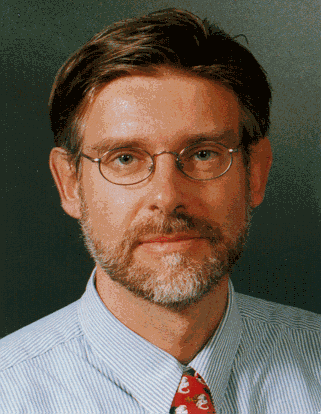

®Kärnten Werbung / Universität Klagenfurt
Workshop on Image Analysis
for Multimedia Interactive Services
 |
| Home |
| Program |
| Call for Papers |
| Invited Talks |
| Special Session |
| Industry Session |
| Committee |
| Submission |
| Registration |
| Sponsors |
| Venue |
| Accomodation |
© 2007-2008 Department of Information Technology, Klagenfurt University, Austria last update: 2008-05-17 by WIAMIS 2008 sponsored by
|
| Invited Talks |
WIAMIS 2008 is pleased to announce the following keynote speakers with tentative titles:
Keynote Speakers
Horst Bischof was co-chairman of international conferences (ICANN, DAGM), and local organizer for ICPR'96. He was program co-chair of ECCV2006 and Area chair of CVPR 2007, ECCV2008. Currently he is Associate Editor for Pattern Recognition, Computer and Informatics and Journal of Universal Computer Science. Horst Bischof has received the 29th Pattern Recognition award in 2002; the main price of the German Association for Pattern Recognition DAGM in 2007 and the Best scientific paper award at the BMCV 2007. Robust Person Detection for Surveillance using Online Learning Recently, there has been considerable amount of research in methods for person detection. This talk will focus on methods for person detection in a surveillance setting (known environment). We will demonstrate that in this setting one can build robust and highly reliable person detectors by using on-line learning methods. In particular, I will first discuss "conservative learning" The basic idea is to considerably simplify the detection problem by considering individual image locations separately. Therefore, we can use simple adaptive classifiers which are trained on-line. Due to the reduced complexity we can use a simple update strategy that requires only a few positive samples and is stable by design. This is an essential property for real world applications which require operation for 24 hours a day, 7 days a week. During the talk we will illustrate our results on video sequences and standard benchmark databases.
From 2001-2004, Dr. Smith served as Chair of ISO/IEC JTC1/SC29 WG11 Moving Picture Experts Group (MPEG) Multimedia Description Schemes group with responsibilities in the development of MPEG-7 and MPEG-21 standards. Dr. Smith also served as co-Project Editor for following parts of MPEG-7 standard: "MPEG-7 Multimedia Description Schemes," "MPEG-7 Conformance," "MPEG-7 Extraction and Use" and "MPEG-7 Schema Definition." He currently leads IBM’s multimedia analysis and retrieval research area. Dr. Smith is IEEE Fellow. Video is rapidly becoming a regular part of our digital lives. However, its tremendous growth is increasing users’ expectations that video will be as easy to search as text. Unfortunately, users are still finding it difficult to find relevant content. And today’s solutions are not keeping pace on problems ranging from video search to content classification to automatic filtering. In this talk we describe recent techniques that leverage the computer’s ability to effectively analyze visual features of video and apply statistical machine learning techniques to classify video scenes automatically. We examine related efforts on the modeling of large video semantic spaces and review public evaluations such as TRECVID, which are greatly facilitating research and development on video retrieval. We discuss the role of MPEG-7 as a way to store metadata generated for video in a fully standards-based searchable representation. Overall, we show how these approaches together go a long way to truly unleash video search.
From 1990 to 1995, he performed work within research projects on image and video coding at the same location. Between 1992 and 2000, he has also served as lecturer on topics of digital image processing, coding and transmission at TUB. From 1996 to 2000, he was project manager/coordinator at the Image Processing Department of Heinrich Hertz Institute (HHI) in Berlin. He was involved in research projects on motion-compensated, stereoscopic and 3-D image processing, image/video coding and content description for image/video database retrieval. Since 1998, he participates in the work of the Moving Pictures Experts Group (MPEG), where he has been active in the development of MPEG-4 and MPEG-7 standards. In 2000, he was appointed full professor and since then holds the chair position of the Institute of Communication Engineering at RWTH Aachen University, Germany. His present research and teaching activities are in the areas of multimedia communication, multimedia signal processing/coding and services for mobile networks, with emphasis on video signals, also including fundamentals of digital communication systems. He has served as a chair of the MPEG Video Subgroup since May 2002. Since January 2005, he is also co-chairing the Joint Video Team (JVT). Prof. Ohm has authored textbooks on multimedia signal processing, analysis and coding, on communications engineering and signal transmission, as well as numerous papers in the various fields mentioned above. Recent, current and future developments in video coding Most recent attention in development of video coding algorithms has been devoted to the ITU-T Rec.H.264 | ISO/IEC 14496-10 Advanced Video Coding standard. Recent and current extensions to this standard include developments for professional applications, highly-efficient scalable video coding and multi-view video coding. Finally, digital video over various networks, going for higher and higher resolutions, is becoming reality. While this technology is progressing and further optimizations are sought, new challenges appear at the horizon. New types of displays include 3D capabilities, requiring for generation of additional view perspectives beyond available camera positions. Cameras and displays are coming up with permanently increasing frame rates and sizes. The tremendous amount of different applications for digital video requires additional flexibility and reconfigurability of devices. And last not least, increased compression efficiency (meaning rate reduction versus processing cost) is again becoming more important with ever increasing numbers of pixels to be transmitted. The talk will focus on possible solutions to these challenges and discuss the maturity they currently have. |




 John R. Smith
John R. Smith Jens-Rainer Ohm
Jens-Rainer Ohm